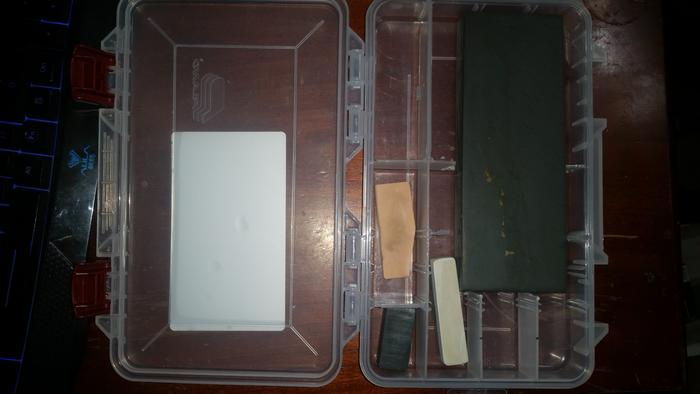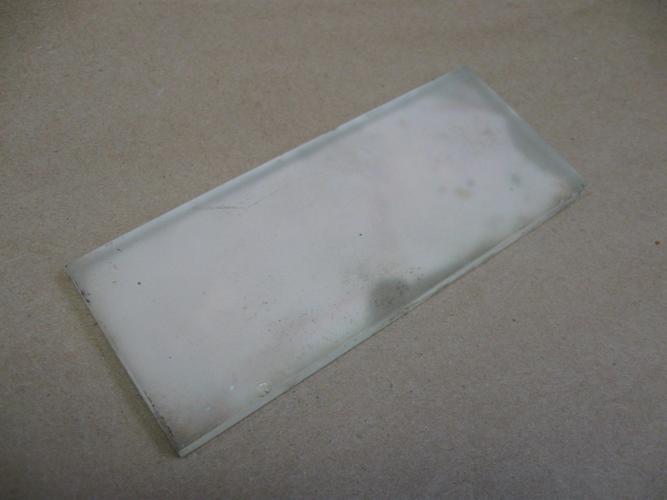Results 1 to 10 of 11
Hybrid View
-
07-24-2017, 05:19 PM #1Junior Member

- Join Date
- Jul 2017
- Location
- Chicago
- Posts
- 22
Thanked: 0 Help me understand Nagura/Slurry Stones
Help me understand Nagura/Slurry Stones
Hey guys, I wanted to understand nagura's a bit better as I'm often left guessing whenever I come across a honing video. Correct me if I'm wrong but assuming one has a base stone of a certain hardness, using a nagura that is softer than the base hone would impart the honing properties of the nagura onto the base stone.
In a second scenario, one could have a base stone that is softer than the nagura/slurry stone and the nagura in that case would be used to break down the base stone. That slurry would be primarily comprised of the base stone itself.
I recently aquired an escher which included a slurry stone. It seems like the slurry stone is softer as the slurry left on the stone appears to match the color of the slurry stone. In this case, wouldn't I get the same result by using the same slurry stone and rubbing it on a hard ark or a piece of granite or glass or whatever? I guess what I'm asking is if the slurry stone isn't cut from the same escher then whats the benefit of using an unknown slurry stone on an escher? To me it seems logical that there wouldn't be any point in using that setup. I think I would be better off using a diamond nagura. Is that correct?
Then I have a coticule which to me is pretty soft. The slurry stone that it came with is hard as hell so I know the slurry being produced with that combo is coming off the coticule.
I like the idea of honing off slurry and wanted to start collecting stones that will allow me to do this but I have no idea if I could simply get myself a big ass hunk of a SB Ark for example, and a set of Jap naguras and do a progression. Does the base stone matter after a certain level of hardness? Assuming that the base hone you're using is harder than anything you would ever use to slurry, would there be a difference between using nagura on a very hard JNAT or an Ark?
Sorry for my noobness. I know I'm kinda all over the place with this post :-)
-
07-24-2017, 06:34 PM #2

The makeup of the stone and what you want to accomplish will play into this. With the coticule the garnets are what's doing the work so by using a hard slurry stone you are releasing the garnets into the slurry which will accelerate the honing process.
Using a softer stone than the hone will create a slurry which will enhance the honing process and exactly how it does that will depend on what is being released into the slurry by the slurry stone.
In any case as you hone slurry from the hone will be produced which will mix with the slurry stone slurry.
I'm sure one of our hone guru's will come by and explain it better.No matter how many men you kill you can't kill your successor-Emperor Nero
-
07-24-2017, 09:19 PM #3

In the Thuringian or coticule 'systems' the slurry stone is used to create slurry to increase cutting speed. Most people I think don't finish with slurry on either of these or possibly a very thin slurry. But I am not an expert with these stones.
In the Japanese system there are two kinds of nagura, a set, usually 3-4, of white or striped chalk type - usually Mikawa nagura - that are graded and these replace graded whetstones, i.e. they for example might replace the 2k, 5k, 8k stones you would usually use in a progression of synthetic stones. You usually use these with your finishing stone. The tomo nagura is usually a piece of stone very similar to the finishing hone and is finer than the Mikawa set. It is also used to increase cutting speed, but it also provides lubrication especially for very hard stones, and the finishing slurry can many times produce a milder or smoother edge than clear water. A worn diamond plate can also be used as a slurry 'stone' and the slurry is 100% from the base stone.
You can't figure them out by hardness of the nagura/hone and understand if they will work for you on a particular razor, with a particular hone, steel, or honing method, you just have to try them.
Hope this helps!
Cheers, Steve
-
07-24-2017, 10:16 PM #4
 Help me understand Nagura/Slurry Stones
Help me understand Nagura/Slurry Stones
I will try to give a reply to your request...as already mentioned Slurry in nearly all cases is used to raise up the speed when honing in natural stones....
Actually in the End there are nearly no fixed rules besides two base facts...
1. ist useful to use a softer stone or a DMT to create a slurry on the base stone
2. you have to hone as often as possible to see what happens when you work with different slurries on different stones with different steels
You can practically calibrate the cutting speed with slurry on a stone....thick pasted slurry most likely removes a lot of metal and isnt that fine....adding water to it the result gets finer but cutting action is reduced....the generel cutting speed is different on each base stone and slurry stone combination███▓▒░░.RAZORLOVESTONES.░░▒▓███
-
07-24-2017, 11:16 PM #5Senior Member



- Join Date
- Dec 2014
- Location
- Virginia, USA
- Posts
- 2,224
Thanked: 481
In the case of your Thuri I would say that is ideal. I prefer the slurry stone to be softer than my base hone, maybe as hard as the stone, but never harder. Little slurry rocks are cheap, full sized hones are not. I would rather wear down the slurry rock than the base hone. In the case of the thuri, slurry might be used to touch up a slightly dulling razor a little faster than just using the thuri with water only. Make a slurry, and dilute it slowly until you can finish on pure water or perhaps a very thin slurry depending on preference. But I think many just touch up on synthetic hones then use their Thuringians as finishers.
In the case of your coticule, I don't think I would be using that slurry stone. Might be worthwhile to find another slurry stone, or to simply use that coticule as a finisher only. My coticule cost me almost a hundred bucks, the little bout 1 rock I used for experiments before obtaining a full size hone was only 12 bucks from SRD.
These are a little different than a Jnat type system. The Thuri would be light touch up and finish only, the coticule medium polish to finishing generally - many move to the coticule from around 5K or so. Jnats are sort of a one stone system where the 'lower grit' nagura does coarse polish/bevel setting, you'll slowly dilute the slurry as it breaks down, then progress through each of the following nagura phases to refine the polish further. I've been advised that a very fine tomo slurry (final nagura phase) is a better finish on a Jnat than pure water, but I've yet to test that with my stone.
You asked if the same thing could be achieved with any hard stone, my answer is: yes. For example, my Cnat setup (poor man's Jnat rig):

The little pink slurry stone is a piece I cut off an 800 grit Naniwa hone. The yellow piece is Coticule. And of course there's the 'tomo' chunk of rock that came with the Cnat. Inside that fishing box is everything I need to hone a razor from bevel set to shaving sharp, using the slurry stones in that order. I've done the same thing on an Arkansas stone, and I have a glass barber's hone that I've done it with as well.

I think it's literally just a piece of frosted glass. I used Welsh slate to create a slurry on it because it specified a piece of slate in it's instructions, but I imagine any stone that's either softer or in the same hardness range as Welsh Slate would work just as well. It made for a really good polish that I was most pleased with by the time I was honing on pure water and glass alone.Last edited by Marshal; 07-24-2017 at 11:23 PM.
-
07-24-2017, 11:58 PM #6

I have tried a host of tomo nagura's and honestly just use a Atoma 1200 slurry and work it and then dilute until almost straight water and finish, I have not tried as many tomo's as some so I am sure others more experienced than me will chime in.
"A Honer's adage "Hone-Shave-Repeat"
~William~
-
07-25-2017, 01:49 AM #7Junior Member

- Join Date
- Jul 2017
- Location
- Chicago
- Posts
- 22
Thanked: 0 Help me understand Nagura/Slurry Stones
Help me understand Nagura/Slurry Stones
Thanks for the info guys. My coti is nowhere near being a finisher. However I love the way it feels and how fast it cuts. Just need to figure out exactly where I can put it in my half assed stone rotation. More importantly though and after reading what you guys posted it did just dawn on me that using a soft slurry stone on a harder hone and working up to plain water was the missing piece for me and I just had an A-Ha! (Duh) moment :-) That makes sense now. I just wasn't considering the dilution phase. Thanks!
Sent from my iPhone using Tapatalk
-
07-25-2017, 05:58 AM #8

I am not an expert but I've been getting very good results on my Coticules by using Dr. Matt method. I use my Coticules after the 8k and without any slurry under running water (very little almost nothing) once the razor starts to stick to the stone, open the faucet a little bit more, and keep honing with no pressure until the blade starts to stick again. You can find the Dr. Matt video on YOUTUBE.
-
07-25-2017, 10:22 AM #9

Coticules need to finish on water, not slurry. Depending on the stone, it may take a fair number (100+) of plain water laps to finish the edge after diluting the slurry. Don't write off your stone as half assed until you've learned how to use it. Coticules are not easy stones to learn and require patience and experimentation. The edge they produce is well worth the effort.
Have a look at this, especially the illustrations that show how the garnets behave in slurry versus under plain water.
http://coticule.be/dilucot-honing-me...Dilucot-EN.pdf
Sent from my iPhone using Tapatalk"Every normal man must be tempted at times to spit on his hands, hoist the black flag, and begin to slit throats." -H. L. Mencken
-
07-25-2017, 11:28 AM #10Senior Member



- Join Date
- Dec 2014
- Location
- Virginia, USA
- Posts
- 2,224
Thanked: 481
The first thing I would do with the coticule is determine if it can finish. There are some that are excellent finishers, some that can be coaxed to fine enough, and some that are a bit of a lost cause in that department. Mine fits in that middle category, with the surface prepared well it finishes just fine. But if I disturb that surface by using slurry it'll be a good long while before it finishes anything. Trying the experiments here may help:
http://straightrazorpalace.com/honin...-me-drink.html


 7Likes
7Likes LinkBack URL
LinkBack URL About LinkBacks
About LinkBacks






 Reply With Quote
Reply With Quote
